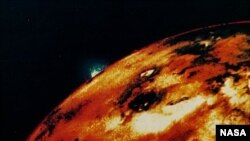Jupiter’s moon Io is the most volcanic body in the solar system, and astronomers recently witnessed an eruption bigger than any ever recorded on Earth.
Dr. Imke de Pater, professor of astronomy and planetary science at the University of California in Berkeley spotted the eruption on August 15, using the Keck II telescope on Mauna Kea in Hawaii.
The eruption took place in the Rarog Patera area of Io, which is 628,300,000 kilometers away from Earth. The area is not known to be particularly active with volcanoes, but is believed to have fountains of lava streaming from fissures on Io’s surface. The region is named after the Czech fire god.
The eruption was “way bigger than anything in recorded history on Earth,” de Pater said, adding that the Rarog Patera eruption was likely 100 to 500 times larger than any of the bigger eruptions here on Earth in recent decades.
According to Ashley Davies of NASA's Jet Propulsion Laboratory in Pasadena, California, the Io eruption emitted about 17,000 times more energy than typically produced by Hawaii’s Kilauea, Earth’s most active volcano.
De Pater said the eruption offers a chance to better understand Io’s volcanic activity.
“There are many things we hope to learn from eruptions like these,” she said. “At this point, we don’t know how long they last -- hours, days, weeks, months.”
Scientists believe the amount of volcanic activity on Io is the result of a gravitational tug of war between Jupiter and some of the massive planet’s other moons.
Data and imagery of the eruption will be released in a forthcoming paper, de Pater said.
Dr. Imke de Pater, professor of astronomy and planetary science at the University of California in Berkeley spotted the eruption on August 15, using the Keck II telescope on Mauna Kea in Hawaii.
The eruption took place in the Rarog Patera area of Io, which is 628,300,000 kilometers away from Earth. The area is not known to be particularly active with volcanoes, but is believed to have fountains of lava streaming from fissures on Io’s surface. The region is named after the Czech fire god.
The eruption was “way bigger than anything in recorded history on Earth,” de Pater said, adding that the Rarog Patera eruption was likely 100 to 500 times larger than any of the bigger eruptions here on Earth in recent decades.
According to Ashley Davies of NASA's Jet Propulsion Laboratory in Pasadena, California, the Io eruption emitted about 17,000 times more energy than typically produced by Hawaii’s Kilauea, Earth’s most active volcano.
De Pater said the eruption offers a chance to better understand Io’s volcanic activity.
“There are many things we hope to learn from eruptions like these,” she said. “At this point, we don’t know how long they last -- hours, days, weeks, months.”
Scientists believe the amount of volcanic activity on Io is the result of a gravitational tug of war between Jupiter and some of the massive planet’s other moons.
Data and imagery of the eruption will be released in a forthcoming paper, de Pater said.








